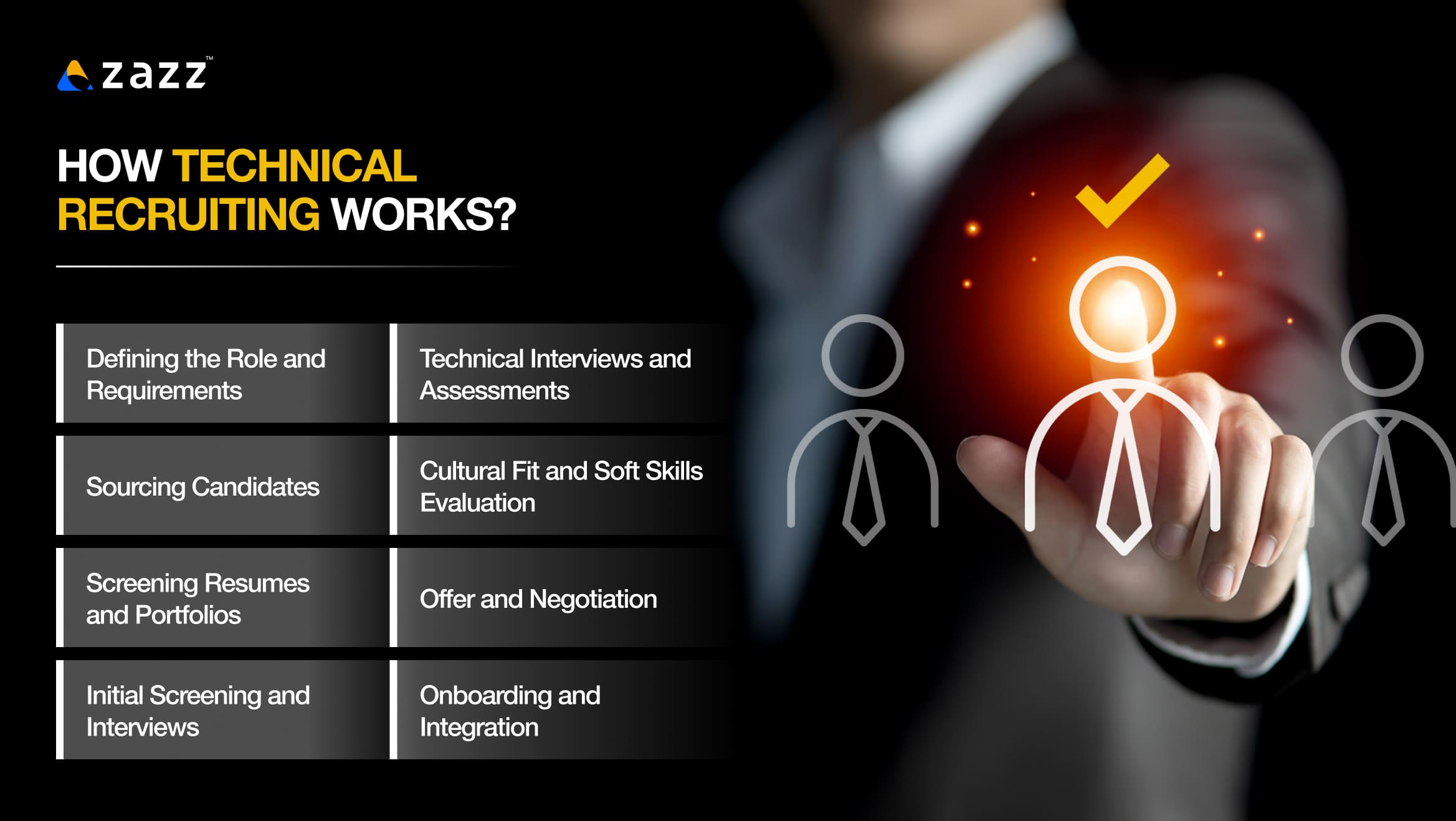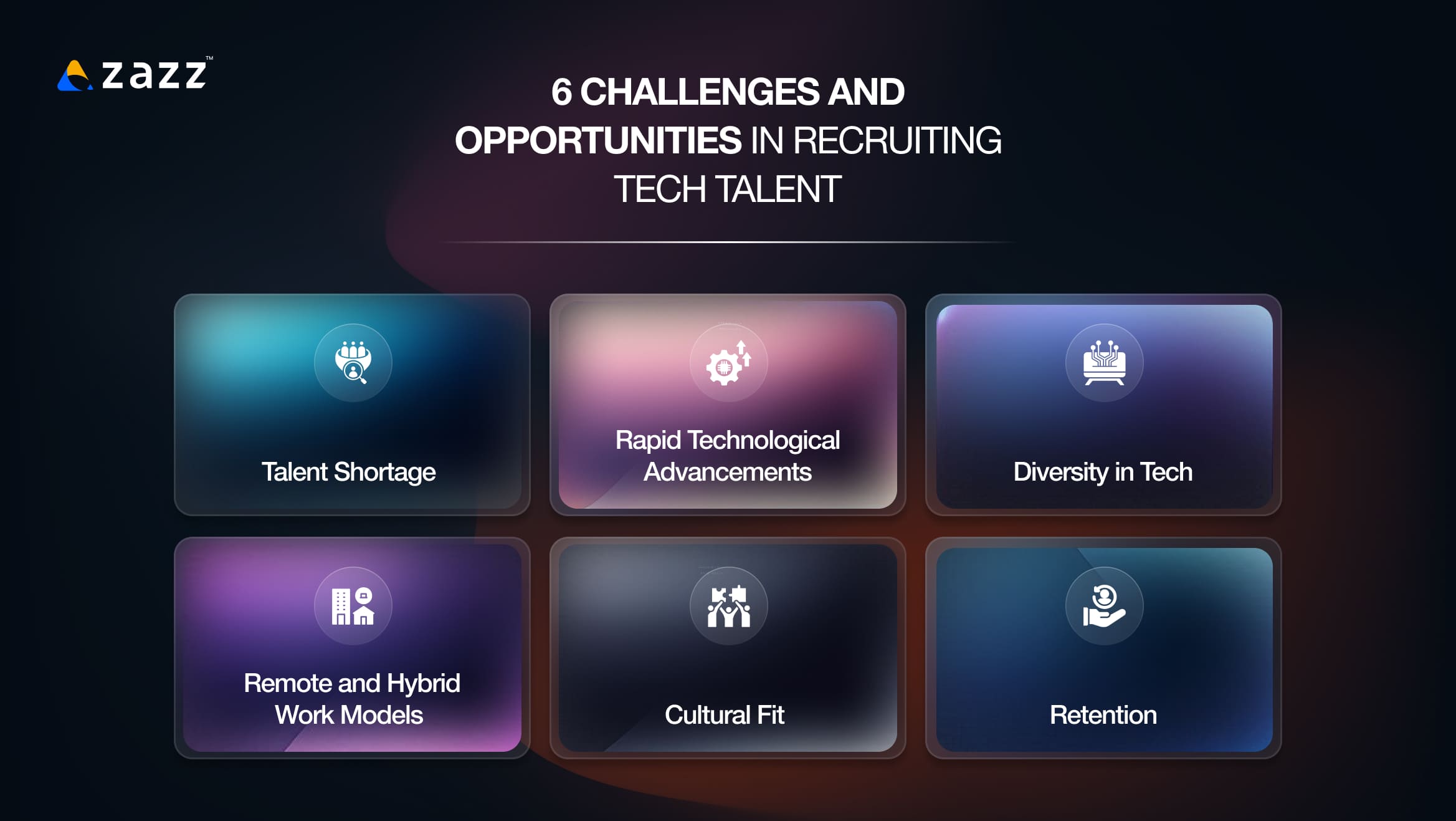
As technology continues to evolve at a rapid pace, hiring tech talent has become one of the most critical aspects of business growth in 2025. The need for skilled professionals in fields like software development, cybersecurity, data science, and artificial intelligence is higher than ever, making it crucial for organizations to adopt effective recruiting strategies. In this guide, we’ll explore how to successfully recruit and hire top tech talent by offering practical insights, addressing common challenges, and sharing actionable tech recruiting tips.
How Technical recruiting works?

Technical recruitment, or tech recruiting, is a specialized process designed to identify, assess, and hire professionals with technical expertise. Unlike general recruitment, which involves filling a variety of roles across different fields, technical recruitment specifically targets candidates for positions in industries such as software development, data science, IT infrastructure, cybersecurity, and other technology-focused roles.
Here’s an overview of how technical recruitment typically works, broken down into key stages:
1. Defining the Role and Requirements
The first step in technical recruiting is to clearly define the role and understand the technical skills needed. This requires collaboration between hiring managers and technical leaders (e.g., engineers or tech leads) to identify the specific tools, programming languages, and expertise required for the role. Job descriptions should not only list qualifications but also clearly define responsibilities, skills, and the technical environment in which the candidate will be working.
Example: If you’re recruiting for a software engineering role, the job description might specify proficiency in Python, experience with cloud technologies (AWS, Azure), and familiarity with agile development practices.
Related reading: Common Tech Hiring Mistakes to Avoid
2. Sourcing Candidates
Sourcing is one of the most crucial steps in technical recruitment. Tech recruiters often tap into a variety of channels to find suitable candidates:
- Job boards: Websites like LinkedIn, Indeed, and Glassdoor offer platforms for posting job openings.
- Tech-specific communities: Platforms like GitHub, Stack Overflow, and specialized tech forums are great places to find active contributors.
- Networking: Attending tech meetups, conferences, and hackathons allows recruiters to engage with candidates who are passionate about the field.
- Referrals: Employee referrals are one of the most effective ways to find high-quality tech talent, as current employees understand the company culture and technical requirements.
3. Screening Resumes and Portfolios
Once applications are received, recruiters sift through resumes, portfolios, and personal websites to screen for the necessary technical skills. They look for evidence of the right tools, technologies, and experiences listed in the job description. Some tech recruiters are familiar with common programming languages and tools, which helps them identify potential candidates even in technical documents like GitHub repositories.
4. Initial Screening and Interviews
After shortlisting candidates, the next step is the initial screening. This typically involves a phone or video interview where recruiters assess the candidate’s communication skills, previous experiences, and motivation for the role. During this phase, recruiters may also ask some basic technical questions to gauge the candidate’s understanding of key concepts.
5. Technical Interviews and Assessments
At this stage, the candidate’s technical abilities are tested. This is one of the most critical steps in technical recruiting. There are several ways recruiters can evaluate a candidate’s technical skills:
- Coding challenges: Platforms like HackerRank or LeetCode allow recruiters to give candidates coding tasks to complete, which test their problem-solving and programming abilities.
- Live coding interviews: In some cases, candidates may be asked to code in real-time during the interview. This can involve solving algorithmic problems, debugging code, or designing a system.
- Technical assessments: These could be in the form of design exercises or project simulations, where candidates are asked to design a system or solve a technical problem the company might face.
6. Cultural Fit and Soft Skills Evaluation
While technical skills are paramount, evaluating a candidate’s cultural fit and soft skills is also critical. In tech roles, collaboration and communication are essential, and a good cultural fit ensures that the new hire will thrive in the company’s environment. Recruiters or hiring managers may ask behavioral questions to understand how candidates interact in teams, approach problem-solving, or handle conflict.
7. Offer and Negotiation
Once a candidate successfully passes all stages of the interview process, the next step is extending an offer. At this stage, recruiters present a formal job offer that outlines the role, salary, benefits, and other important details. In tech recruiting, negotiation is common, especially around salary, bonuses, equity, and remote work options.
8. Onboarding and Integration
After the offer is accepted, the recruiter’s role may extend into the onboarding process. A smooth onboarding experience is essential for ensuring that new hires feel welcome and can start contributing quickly. This could involve setting up their work environment, introducing them to the team, and providing any necessary training or documentation.
The best option to bypass this entire technical recruitment process is “Staff Augmentation”, a highly reliable option to find vetted tech talents without a hassle. Find your best fit at Zazz- a leading staff augmentation company that has Top 1% vetted tech talents from onshore, offshore and nearshore.
Why Tech Recruiting Is Different from General recruitment
Unlike traditional recruitment for non-technical roles, recruiting tech talent demands a more in-depth understanding of the specific skills required for each job. It’s about evaluating a candidate’s hands-on experience and technical knowledge, not just their academic background or previous job titles. Tech recruiters need to be able to speak the language of technology and understand the day-to-day challenges faced by the roles they are hiring for.
Moreover, hiring tech talent often involves an additional layer of complexity: the competition. The tech industry is booming, and top talent is in high demand. Companies must create attractive opportunities, competitive compensation packages, and robust career growth paths to lure skilled professionals.
Get past all the complexities of hiring tech talents in this competitive market with Zazz– Your trusted Staff Augmentation partner that offers Top 1% vetted tech talents from across the globe.
Related reading: How to Build a High-Performing Tech Team
6 Challenges and Opportunities in Recruiting Tech Talent

1. Talent Shortage
There is a persistent shortage of qualified candidates in fields like software engineering, data science, and cybersecurity. This has created a highly competitive market where companies are fighting over a limited talent pool.
Opportunity: By diversifying your recruiting channels and offering remote work options, you can expand your search and access a broader pool of talent, including candidates from different geographic locations.
Talent shortage will no longer be a concern as staff augmentation companies like Zazz give you access to Top vetted 1% tech talent. All you just have to do is, pick the right talent that fits your needs and you can get started with your project in a week’s time.
2. Rapid Technological Advancements
Technology evolves quickly, and recruiters must keep pace with the latest developments in areas like AI, machine learning, and cloud computing.
Opportunity: Focus on candidates who demonstrate the ability to learn and adapt to new technologies. Prioritize hiring individuals with a growth mindset and a willingness to stay current.
3. Diversity in Tech
The tech industry has historically struggled with diversity, and it remains a challenge in 2025. Many companies are focused on increasing diversity and inclusion, but finding and attracting underrepresented talent is still difficult.
Opportunity: Partner with organizations, mentorship programs, and educational institutions that focus on underrepresented groups in tech. By proactively reaching out to diverse communities, you can increase diversity and bring fresh perspectives to your team.
4. Remote and Hybrid Work Models
In 2025, remote and hybrid work models are increasingly popular, particularly in the tech industry. Candidates are looking for flexibility and work-life balance in addition to competitive salaries.
Opportunity: Offer remote or hybrid roles to attract a wider range of candidates, including those outside your local talent pool. Be clear about your company’s policies regarding remote work and flexibility.
5. Cultural Fit
In addition to technical expertise, cultural fit is essential in recruiting top tech talent. Candidates need to align with your company’s values and work well within your existing teams.
Opportunity: Evaluate cultural fit alongside technical skills by incorporating behavioral interviews and team-based activities in the hiring process. This will help ensure that the candidate is not only technically capable but also a good match for your team.
6. Retention
Once you’ve recruited tech talent, the next challenge is retention. High turnover rates in the tech industry can be costly, especially for highly skilled professionals.
Opportunity: Focus on employee development, mentorship, and career progression to retain top talent. Offering growth opportunities within your organization can help prevent burnout and promote long-term loyalty.
Related reading: Staff Augmentation Pricing Model : A Complete Guide
Current Tech Hiring Trends

Several trends are shaping the landscape of tech hiring in 2025:
- Emphasis on Soft Skills: While technical skills remain critical, there is an increasing emphasis on soft skills such as communication, problem-solving, and teamwork. In a collaborative tech environment, these skills are essential for success.
- AI and Automation in Recruiting: Companies are increasingly leveraging AI tools and automated recruitment platforms to screen resumes, conduct initial candidate assessments, and even predict future success. These tools save time and improve efficiency, allowing recruiters to focus on higher-level decision-making.
- Diversity and Inclusion Efforts: Companies are more committed than ever to increasing diversity within their tech teams. A diverse team brings different perspectives, fosters innovation, and improves problem-solving, which is essential for success in the tech industry.
- Remote Work Opportunities: With the growth of remote work, companies can hire tech talent from anywhere in the world. This trend enables businesses to tap into new markets and offer more flexible working conditions to attract top candidates.
5 Tips for Technical Recruiting

Now that we’ve explored the challenges and trends in recruiting tech talent, let’s discuss five key tech recruiting tips that will help you build a successful hiring strategy:
1. Focus on Skills, Not Just Credentials
While a degree or traditional credentials might look good on paper, tech talent today often comes from diverse educational backgrounds. Many candidates have honed their skills through boot camps, self-learning, or open-source contributions. Shift your focus to assessing practical skills, real-world problem-solving abilities, and hands-on experience.
2. Use Technical Assessments and Coding Challenges
Incorporating technical assessments, coding challenges, and system design problems into your interview process is crucial for evaluating candidates’ actual abilities. It’s important to use assessments that simulate the work the candidate will be doing on the job to accurately gauge their skills.
3. Leverage Your Network
Encourage current employees to refer candidates and use platforms like LinkedIn, GitHub, and tech meetups to connect with potential candidates. Networking within the tech community can help you find passive candidates who might not be actively seeking a job but are open to new opportunities.
4. Offer Competitive Compensation Packages
In a competitive tech market, offering competitive salaries and benefits is essential for attracting the best candidates. Beyond base salary, consider offering flexible work hours, remote work options, bonuses, and opportunities for professional development.
5. Foster an Inclusive Company Culture
Top tech talent wants to work in an environment where diversity is valued and inclusion is a priority. Make sure your hiring process is inclusive and that your workplace fosters a supportive culture for all employees.
Staff Augmentation – The Smartest Way to Hire Tech Talent
Staff augmentation has become a go-to solution for companies looking to quickly scale their teams with specialized tech talent without the long-term commitment of traditional hiring. This approach allows businesses to bring in experienced professionals for short-term or project-based needs, enabling them to meet deadlines, address skill gaps, or support critical initiatives. Companies like Zazz have mastered the art of staff augmentation by providing highly skilled, vetted tech professionals who seamlessly integrate into existing teams. Whether you need a developer to work on a specific project or a data scientist to enhance your analytics capabilities, Zazz ensures that you get the right talent at the right time, helping your business stay agile and competitive without the overhead of hiring full-time employees. Through staff augmentation, Zazz enables businesses to gain access to a broader talent pool, reduce recruitment timelines, and maintain a flexible workforce that can adapt to changing demands.
Related reading: IT Staff Augmentation Process, Pros and Cons
Conclusion
In 2025, recruiting top tech talent requires a strategic approach that combines a deep understanding of the technical landscape with a focus on culture and user experience. By following a technical hiring guide that emphasizes skills over credentials, incorporating structured assessments, and offering competitive compensation, you can successfully recruit and hire the best tech professionals.
Whether you’re recruiting tech talent for the first time or looking to refine your current process, the key is to adapt, innovate, and focus on what makes your company an attractive place to work. Incorporating technical recruiting tips into your hiring process and staying ahead of trends will ensure that you’re able to navigate the competitive world of tech recruiting and build a strong team that drives innovation and success.
Frequently Asked Questions
Tech recruiting refers to the process of sourcing, interviewing, and hiring professionals with specialized technical skills. Unlike general recruitment, which focuses on a broader range of roles, tech recruiting specifically targets candidates for positions in fields like software engineering, data science, cybersecurity, and IT. It requires a deeper understanding of the technical qualifications needed for each role and the ability to evaluate candidates’ hands-on experience with programming languages, frameworks, and tools.
One of the main challenges in recruiting tech talent today is the fierce competition for skilled professionals. With the increasing demand for developers, data scientists, and cybersecurity experts, companies often find themselves competing for the same candidates. Other challenges include staying up-to-date with rapidly evolving technologies, ensuring diversity in tech teams, and offering competitive compensation packages to retain top talent. However, there are opportunities to address these challenges, such as expanding the search to remote candidates and focusing on skills-based assessments instead of just traditional credentials.
Certainly! Here are a few technical recruiting tips to help improve your hiring process:
- Prioritize hands-on skills over academic credentials—assess real-world problem-solving abilities rather than relying solely on degrees.
- Implement technical assessments and coding challenges to test candidates’ skills in action.
- Focus on offering flexible work options, such as remote or hybrid work, which is increasingly important to tech professionals today.
- Build a strong employer brand by showcasing your company’s culture, innovation, and commitment to employee development.
To assess a candidate’s technical abilities, consider using a combination of coding challenges, live problem-solving scenarios, and system design interviews. Technical hiring guides often recommend structuring the interview process around real-world tasks the candidate would face in the role. This approach ensures that the assessment tests relevant skills and provides a better sense of the candidate’s problem-solving approach. Pair this with behavioral interviews to also evaluate soft skills, such as communication and teamwork, which are just as important in tech roles.
Recruiting top tech talent can significantly boost your company’s performance by bringing in experts who can develop innovative solutions, improve product offerings, and streamline internal processes. Skilled tech professionals can help your company stay competitive by adopting cutting-edge technologies and ensuring your digital infrastructure is robust and scalable. By hiring the right people, you’re not just filling positions; you’re investing in long-term success and growth in an increasingly tech-driven world.
Tips for technical recruiting don’t just focus on attracting candidates—they also extend to retaining them once they’re hired. To keep your tech talent, consider:
- Providing continuous learning opportunities, such as workshops, certifications, and access to new technologies.
- Fostering a collaborative environment that encourages creativity and innovation.
- Offering competitive benefits like flexible schedules, remote work options, and professional development support.
- Creating clear career paths to show employees how they can grow within your company. These strategies will help you retain top talent and reduce turnover.
Recent Articles
Table of Content 1. Data Engineer vs. Data Scientist: Understanding...
Table of Content 1. What is the Carnival in Brazil?...
Table of Content 1. What is IT Staff Augmentation? 2....












